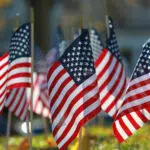For many of us, the Pledge of Allegiance was something we knew by heart and recited each morning in school. With our right hands over our hearts and our eyes cast upward at the flag on the wall, we were taught to show our patriotism. The history of the Pledge is long and fraught with controversy in recent years, so no individual American’s experience with it is universal! Today, the Pledge of Allegiance goes as follows:
“I pledge allegiance to the Flag of the United States of America and to the Republic for which it stands, one Nation under God, indivisible, with liberty and justice for all.”
History of Pledge of Allegiance Day
The first iteration of a patriotic Pledge of Allegiance was penned in 1885 by Civil war veteran Colonel George Balch, but it shares almost no similarities to the Pledge of Allegiance many of us learned in grade school! It wasn’t until 1892 that Francis Bellamy, an editor at the children’s magazine “The Youth’s Companion”, was asked to write a patriotic verse to celebrate the 400th anniversary of Columbus touching down on the continent that the official original version of the Pledge was written.
Bellamy, who was both a former Baptist minister and a Christian socialist, was inspired by the French concepts of “Liberty, Equality, and Fraternity” while writing the Pledge. What he came up with is similar to what is recited in schools today, excluding the phrase “under God” — but we’ll get around to explaining that.
Over the late 1800s and early 1900s, the pledge was widely adopted in schools, and Balch’s Pledge was dropped. Small tweaks were made in the text, but the meaning remained unchanged. For example, today we say “I pledge allegiance to the Flag of the United States of America,” which wasn’t always the case! The National Flag Conference added the phrase “of the United States of America” in 1923 and 1924. Congress formally adopted the Pledge in 1942, declaring that it should be recited with one’s right hand over one’s heart.
One of the more significant changes occurred in 1954 when President Eisenhower asked Congress to add the controversial phrase “under God” to the text. This was an effort to differentiate the American way in communist times. There has also been great debate over whether schools should require children to recite the pledge — even before the religious addition. One 1940 ruling, which compelled children to say the pledge, was quickly overturned by a 1943 ruling. Jehovah’s Witnesses presented significant challenges to the mandatory pledge in the 1930s and 1940s, as they found it to be a form of idolatry and went against their religious beliefs.
In 2004, there was a ruling that children did not have to stand for the pledge. This followed a 2002 Ninth Circuit Court of Appeals case in which an atheist, whose daughter would soon start school, argued that the pledge was an unconstitutional endorsement of monotheism. Between 2006 and 2015, there have been over 5 significant court cases challenging- or somehow related to the phrase “under God” — the most recent 2015 ruling stated that the phrase did not violate any atheist rights.
Pledge of Allegiance Day timeline
Colonel Balch drafts the first pledge of allegiance in 1885, though it is not widely adopted and enjoys only short-lived popularity.
“The Youth’s Companion” editor Francis Bellamy writes what we now call the Pledge of Allegiance in honor of the anniversary of Columbus touching down in North America.
It isn’t until 1942 that Congress officially recognizes the Pledge of Allegiance as we know it today.
During the Cold War, Eisenhower urges Congress to add the phrase “under God” to the words “one Nation”. This controversial move is originally intended to distance America from Communism and leads to hot debate.
Pledge of Allegiance Day FAQs
Where is National Pledge of Allegiance Day celebrated?
The United States.
Are there other National holidays on December 28?
Yes! December 28 is also National Call a Friend Day, National Chocolate Candy Day, and National Download Day.
Are there other National patriotic holidays?
Yes! Some of the most notable other holidays in honor of the United States are Memorial Day, Veteran’s Day, Independence Day, and Columbus Day.
How to Observe Pledge of Allegiance Day
Learn the history
First penned in August of 1892 by Francis Bellamy, the Pledge has certainly evolved over the centuries — along with the public’s opinion of it. Today, spend time reading up on just how the Pledge came to be.
Recite the Pledge of Allegiance
Perhaps obvious, but a great way to celebrate Pledge of Allegiance Day is by doing just that — pledge your allegiance! If you haven’t recited the Pledge since childhood, it’s a great way to affirm your patriotism and be reminded of an important part of American history.
Post #PlegeOfAllegianceDay on social media
After you’ve refreshed your memory on the Pledge of Allegiance, post about it to spread the word on Pledge of Allegiance Day. You could inspire patriotism in someone in your circle, or lead friends to better understand the history of the Pledge.
5 Facts About The Pledge Of Allegiance
Lines were added
The controversial end of the line “one Nation under God” was not originally written this way! The phrase “under God” was added in the 1900s.
There was some confusion about who really wrote it
Two editors, James B. Upham and Francis Bellamy, were both thought to have potentially written the pledge, but the author has since been proven to be Bellamy.
Jehovah’s Witnesses disagreed with it
Arguing that it was against their religious beliefs, a group of Jehovah’s Witnesses opposed the 1943 ruling that children must say the pledge in school.
There is an etiquette
Proper etiquette while reciting the Pledge include military members saluting, men taking off their hats, and citizens placing their right hands on their hearts.
It once said “My flag”
Where today we say “the flag of the United States of America,” the original Pledge simply said “the Flag.”
Why Pledge of Allegiance Day is Important
It’s patriotic
There’s no better way to reaffirm your love for your country than taking the Pledge of Allegiance. The Pledge is meant to make Americans proud of our land and people, so celebrating Pledge of Allegiance day is truly patriotic!
It’s a part of our history
The Pledge of Allegiance had a difficult journey in history to arrive where it is today. Researching the Pledge’s metamorphosis throughout distinct eras of history gives insight into America’s background — it’s worth a bit of reading.
It honors people who serve the country
From government officials to military members, many people who selflessly serve our nation feel honored to hear people reciting the Pledge of Allegiance. It’s a way to thank them for their sacrifices!
Pledge of Allegiance Day dates
| Year | Date | Day |
|---|---|---|
| 2025 | December 28 | Sunday |
| 2026 | December 28 | Monday |
| 2027 | December 28 | Tuesday |
| 2028 | December 28 | Thursday |
| 2029 | December 28 | Friday |











